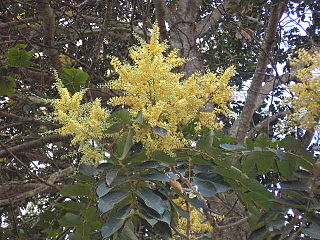
Characidae, the characids or characins, is a family of freshwater subtropical and tropical fish belonging to the order Characiformes. The name "characins" is an historical one, but scientists today tend to prefer "characids" to reflect their status as a, by and large, monophyletic group. To arrive there, this family has undergone much systematic and taxonomic change. Among those fishes remaining in the Characidae currently are the tetras, comprising the very similar genera Hemigrammus and Hyphessobrycon, as well as a few related forms, such as the cave and neon tetras. Fish of this family are important as food in several regions, and also constitute a large percentage of captive freshwater aquarium fish species.

The Atlantic Forest is a South American forest that extends along the Atlantic coast of Brazil from Rio Grande do Norte state in the northeast to Rio Grande do Sul state in the south and inland as far as Paraguay and the Misiones Province of Argentina, where the region is known as Selva Misionera.

Brazil competed at the 1980 Summer Olympics in Moscow, USSR. 106 competitors, 91 men and 15 women, took part in 72 events in 14 sports. Brazilian athletes won two gold medals after a drought of 24 years, since the 1956 Summer Olympics, as well as two bronze medals.

Itabirito is a municipality in the Minas Gerais state of Brazil. Its population is estimated to have 52,446 people in 2020. The city belongs to the mesoregion Metropolitan of Belo Horizonte and to the microregion of Ouro Preto.

Astereae is a tribe of plants in the family Asteraceae that includes annuals, biennials, perennials, subshrubs, shrubs, and trees. They are found primarily in temperate regions of the world. Plants within the tribe are present nearly worldwide divided into over 250 genera and more than 3,100 species, making it the second-largest tribe in the family behind Senecioneae.
Astronium lecointei is a timber tree, which is native to Brazil.
Hisonotus is a genus of armored catfishes native to South America. Species of Hisonotus and Curculionichthys are the only representatives of the subfamily Otothyrinae having serrae on the posterior edge of the pectoral fin spine. These species are small fishes, generally found in small fast flowing streams, where they grasp to the branches and leaves of aquatic or subaquatic plants. The species of this genus mostly occur in Atlantic coastal streams of southern Brazil and the Paraguay-Paraná system of southern South America. They are also distributed in the Río de La Plata basin and coastal rivers of southeastern Brazil.

Tachigali is a flowering plant genus in the legume family (Fabaceae). It includes 74 species of trees native to the tropical Americas, ranging from Nicaragua to Bolivia, Paraguay, and southern Brazil. Typical habitats include tropical rain forest, lower montane forest, seasonally-flooded and non-flooded evergreen lowland forest and woodland, gallery and riparian forest, sometimes on white sands, cerrado and other dry woodland, and rocky grassland.
Oedochloa ecuadoriana, synonym Echinolaena ecuadoriana, is a species of grass in the family Poaceae. It is endemic to Ecuador.

Piresia is a genus of South American plants in the grass family.
- Piresia goeldiiSwallen - French Guiana, Suriname, Venezuela (Amazonas), Colombia (Amazonas), Ecuador, Peru (Loreto), Brazil
- Piresia leptophyllaSoderstr. - Colombia (Amazonas), Ecuador, Peru, Brazil(Pernambuco, Amazonas, Bahia), Trinidad & Tobago
- Piresia macrophyllaSoderstr. - French Guiana, Peru, Brazil
- Piresia palmulaM.L.S.Carvalho & R.P.Oliveira - Brazil (Bahia)
- Piresia sympodica(Döll) Swallen - Venezuela, French Guiana, Suriname, Guyana, Colombia, Ecuador, Peru, Brazil, Trinidad & Tobago

Raddia is a genus of South American plants in the grass family, most of the species found only in Brazil.
Reitzia is a genus of plants in the grass family.
Streptostachys is a genus of South American plants in the grass family.
Diandrolyra is a genus of Brazilian plants in the grass family.
- Diandrolyra bicolorStapf - Espírito Santo
- Diandrolyra pygmaeaSoderstr. & Zuloaga ex R.P.Oliveira & L.G.Clark - Bahia
- Diandrolyra tatianaeSoderstr. & Zuloaga - São Paulo, Bahia, Rio de Janeiro, Espírito Santo

Olyra is a genus of tropical bamboos in the grass family. It is native primarily to the Western Hemisphere, with one species extending into Africa.

The Brazil women's national under-20 volleyball team represents Brazil in international women's volleyball competitions and friendly matches under the age 20 and it is ruled by the Brazilian Volleyball Federation that is a member of South American volleyball body Confederación Sudamericana de Voleibol (CSV) and the international volleyball body government the Fédération Internationale de Volleyball (FIVB).

The Brazil women's national under-18 volleyball team represents Brazil in international women's volleyball competitions and friendly matches under the age 18 and it is ruled by the Brazilian Volleyball Federation that is a member of South American volleyball body Confederación Sudamericana de Voleibol (CSV) and the international volleyball body government the Fédération Internationale de Volleyball (FIVB).
Parianella is a genus of flowering plants belonging to the family Poaceae.

Pleroma is a genus of flowering plant in the family Melastomataceae, native from Puerto Rico and the Leeward Islands to tropical South America.










